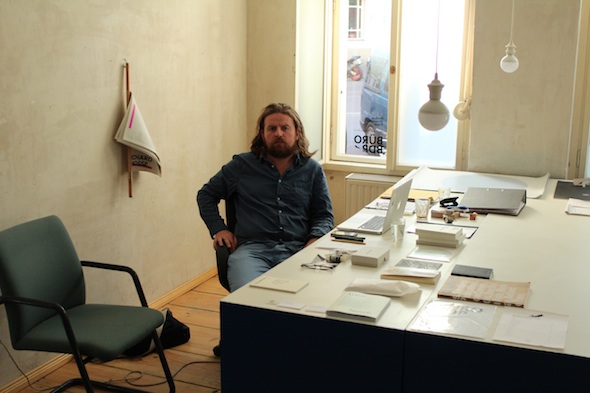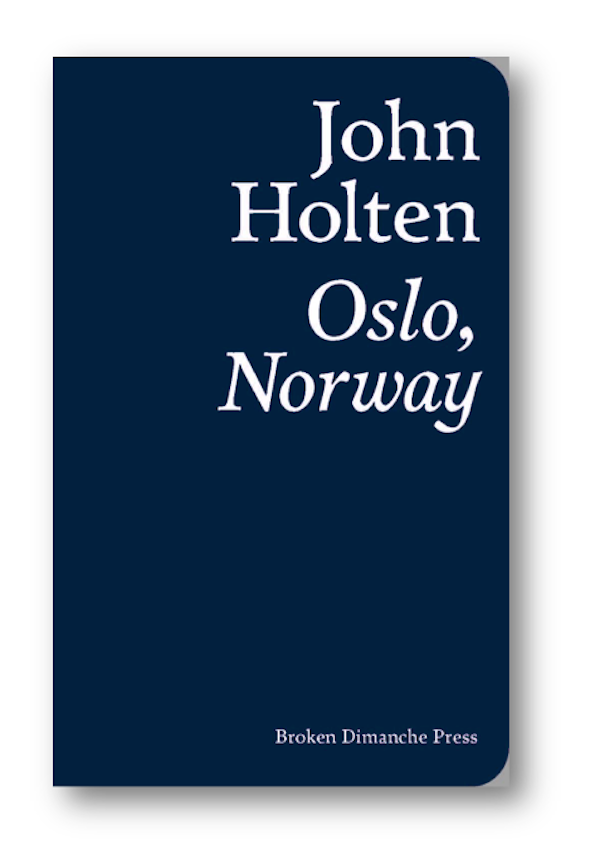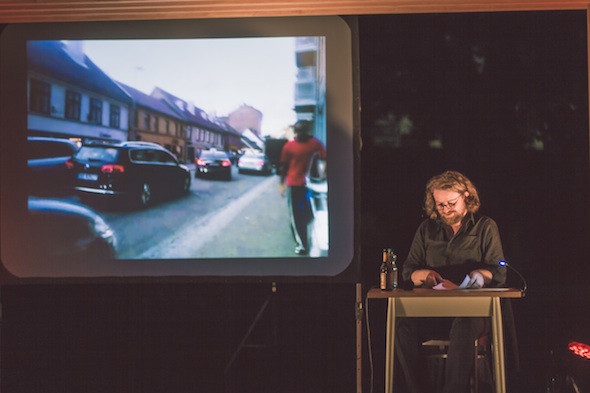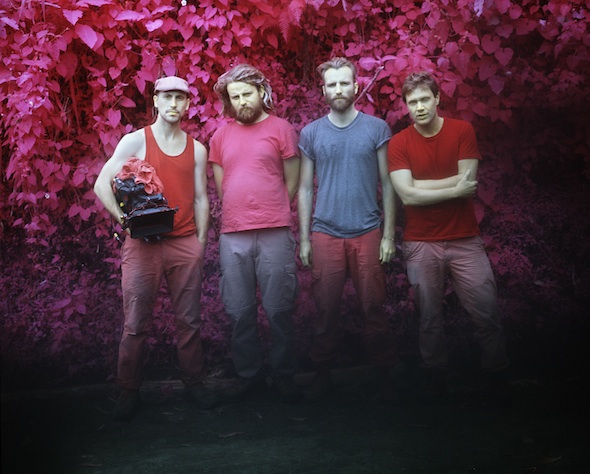Interview by Alison Hugill in Berlin; Thursday, Apr. 23, 2015
In 2009, John Holten co-founded Berlin-based publishing house Broken Dimanche Press. Since then, BDP has executed a variety of books, journals, readings and exhibitions at the crossroads of literature and contemporary art. Holten’s latest novel, Oslo, Norway is a literary atlas, mapping the eponymous city as well as the protagonist’s experience in love. In advance of the book’s launch, Berlin Art Link visited Holten at Büro BDP in Rixdorf to discuss fictional events, both literary and tangible.
 John Holten at Büro BDP, April 2015; Photo: Andre Fuchs
John Holten at Büro BDP, April 2015; Photo: Andre Fuchs
Alison Hugill: Your first book The Readymades spawned a fictional art group called LGB, which later exhibited in real life. You also run Broken Dimanche Press. Can you talk about how the different facets of your work come together both in fiction and reality?
John Holten: I came to Berlin to start writing a novel – The Readymades – out of which came The LGB Group. Before I reached any conclusion with The Readymades I became bored and so, like any novelist, I created a distraction. Some novelists perfect stationary, they waste time fixing the blinds or whatever else might distract them from writing. I made a book, which was an anthology of people who are touched by Berlin or intersect with Berlin. We released that under an imprint. Within the two years it took to write The Readymades the press had made two books and done a number of events. I was faced with a dilemma: as a literary novelist, to self-publish was really a dirty word…and still is to some extent though it’s changing by the minute.
I was always really inspired by the history of Metronome Press, and the longer history before that of artists at the intersection of small presses. Someone like Tom McCarthy, the British novelist, is a good example. When it came to finding a literary agent and looking at traditional roads to publishing in London, I realized that they would change The Readymades. They would ask to not have any images of an art group that didn’t exist, and not promote it with a series of exhibitions. I had already done a number of books, so in the end I decided to do it with Broken Dimanche Press.
At the time the press wasn’t anything more than a couple of smoke and mirror allusions to a real institution – like a logo and a website. Then we moved into an office and got a bit more serious. I was still calling the press a fiction, and I felt very much that fiction was my artistic medium. I saw the press was a big illusion, a trick that we were a publishing house but we weren’t, necessarily. Like any good fiction it was built on details and metaphor. We made more books and did more events. It was something similar to the fictional art group LGB: a fiction that was active in the real world. Everything was a hyper-realistic experiment.
The conceit of literary fiction – lyrical realism as Zadie Smith called it – is that it wants you to believe that it’s real, that it could or did happen. People really like the illusion of reality, whether it be reality TV or appropriated text, all remixed. There’s no great original utterance anymore. All these thoughts were all in the air at the time and we thought ‘Let’s really blow this conceit up!’ And yet The Readymades and Broken Dimanche Press were never really interested in post-modern deceitful tactics, or in digital gestures like post-internet art. The decision was always to make really beautiful books – a wild decision when you’ve got no money. There was a belief in the sincerity of the gesture of making a book, and the whole editorial process.
My practice grew in managing all these different versions of fictions that suddenly I couldn’t call fictions anymore. I couldn’t call the publishing house a fiction anymore, probably around the time I started to work with Hanne Lippard, because it’s a really big responsibility to publish someone else’s book.
I began to question fiction, which is the thinking that Oslo, Norway was born out of.
 Cover of Oslo, Norway; Design: FUK Graphic Design Studio
Cover of Oslo, Norway; Design: FUK Graphic Design Studio
AH: Let’s talk about Oslo. It’s described as a ‘literary atlas’, in two senses: a map of the city and a map of the main character, William’s, experience of love. Your aim is to highlight subjective distortions: “the discrepancy between any map and the territory it represents.” What kind of conscious effort went into this mapping as you constructed the book?
JH: Formally, the book took a really long time to figure out because I got really interested in the idea of non-sequential reading. The Readymades had a very finely tuned structure: in the middle there was a very boring part that was a theoretical background to The LGB Group and I think I lost a lot of readers at that point. Also I think a lot of people find it really difficult to get through a novel. Myself included, during the course of writing this novel my reading has really suffered.
I decided this was something I really needed to address. The book was always going to be episodic but suddenly it became very important that the episodes didn’t need to follow one after another. I started to construct them in different pronominal perspectives. Then I thought of the idea of a street atlas. I had done a big cycling trip to Documenta and I got fascinated by the idea that to continue along the road, you don’t necessarily turn the next page in contiguity with the one you’re on, but rather you jump around a bit. This was visually very interesting. This is how my book became visually concretized and mapped out. A literary example would be Julio Cortazar, a Mexican novelist, he had a kind of choose-your-own-adventure style construction in his novel Hopscotch or Jacques Roubaud and Michel Butor.
I also played with randomness: there’s 52 sections and I put them into a random sequencer on the internet. That didn’t work. So I ended up going back to the initial four divisions of ‘Him’, ‘Them’, ‘You’ and ‘I’. And I like to think they are arranged in such a way that it’s not a failure on the book’s behalf if it’s not read from cover to cover in a straight line.
It became an ontological question of the book’s success or failure: is it a failure – as with any work of art – if it’s not viewed the whole way through? Video art has this issue all the time. I want the book to be made for how we read today online, which is digressive and circular.
AH: In your section called ‘Holmenkollen’ you write that the lovers “must become the guide to a territory marked out on a shared map.” Is the map a metaphor for both the structure and the subject matter of the book?
JH: Yes, the book is about love and the fictions we tell each other while falling in love. The novel came out of being really upset with fiction and also being really upset in love, in real life. You can have a couple who, when they break up, have experienced totally different things and that is often the source of conflict. It also deals with falling in love in different countries: trying to get along with, not just the person you’re in love with, but everything that comes along with them culturally. I make that explicit by putting a foreigner in the streets of Oslo and making him go in and out of a relationship with a woman he’s in love with, who in turn is in love with the idea of the foreign as an exotic or playful source of entertainment for herself. So that corresponds again to the idea that the map can never properly represent the territory that it sets out to cover and yet we need maps to orientate us in the world. Love is full of those pitfalls and trappings and so is fiction. Lyrical realism is a conceit, but it’s a conceit that we seem to need.
 John Holten reading from Oslo, Norway in front of Blip#3, Thyssen-Bornemisza Art Contemporary, Vienna, August, 2014; Photo: Daniel Gottschling
John Holten reading from Oslo, Norway in front of Blip#3, Thyssen-Bornemisza Art Contemporary, Vienna, August, 2014; Photo: Daniel Gottschling
AH: You’re planning to read the full novel in one sitting at your launch on April 25th, to investigate these different modes of attention and readership. Why is that important for you?
JH: I’m still trying to figure out how long it will take and exactly how it will be. It’s not an original gesture at all: Travis Jeppesen did it in the last year or two with The Suiciders, perhaps because he’s really interested in object-oriented art writing, I’m not sure. The most obvious reason that I’m doing it is that literary events really bore me, they really tire me out. I’m trying to react against that. And this time I don’t have a fictional art group that I can explicitly show, so I’m going to explicitly show the whole artwork, for one or two reasons.
First, I want to make a comment on the fact that Broken Dimanche Press don’t make digital editions yet. The book is really well made, it’s being printed here in Berlin, and we’re conscious of that decision. And then there’s an expectation with culture in general at the moment, that you can get it for free, readily. If I’m honest about it, I think that all the time: I go home and think it’s somehow my right to access a whole movie for free. Downloading has been around in movies and music for a long time. In literature it’s happening more. So as a sort of tongue-in-cheek joke I’m giving the whole content away for free, in one singular gesture. People will be able to come and go, which ties into the idea that you can dip in and out of this book. I want to be slightly disrespectful to the novel. I’m not going to be reading it eloquently and I won’t force people to sit down and listen to it. Ultimately, it’s just a shoddy performance, and I’m airing the whole content.
AH: You put out these short ‘Blips’ – trailers for the book that give excerpts of the story but with a real world, spatial orientation.
JH: I wanted the fictitious event to begin already in the conception of the book. I was promoting this book for the last two years with readings in different settings. With The Readymades it all began once the book came out. Oslo, Norway is kind of the complete inversion of that. In the past I was a bit embarrassed to be so much a part of the machinations of publishing my own work, but this time I feel that’s really something to be celebrated. What’s often criticized about mainstream literary publication is that the marketing department has an editorial role in the output and how the books are made, aesthetically. I think books can be a lot better made and celebrated as haptic objects and so I wanted to make this offhand gesture of being my own marketing department and publicist, for a book that would come out in some foreseen future. I shot all the images on my cellphone and edited it super simply, there’s no soundtrack. They’re really unadorned. I sometimes work with really good filmmakers so it was more of a comment on other kinds of video art. I’m also interested in how something can be really good by being inherently really bad.
 Trevor Tweeten, John Holten, Ben Frost and Richard Mosse, South Masisi, Congo. November 2012; Photo: Abdu Namula Jean Bedel
Trevor Tweeten, John Holten, Ben Frost and Richard Mosse, South Masisi, Congo. November 2012; Photo: Abdu Namula Jean Bedel
AH: Speaking of filmmaker friends: you travelled to the Congo with Richard Mosse when he was working on his Enclave videos. Did that affect your work?
JH: Yes and that all happened at the time when I started to write the novel. I ran out of steam and suddenly Richard asked me to go to the Congo, to work a book with him for his show in Venice. I had included Richard in an issue of The Kakofonie, a series we do in the publishing house. I went with him for two months to the Congo and travelled with him through this incredible art-making process and collaboration with Ben Frost and Trevor Tweeten, working with real masters in each of their respective art forms. They were shooting with 16mm film and it was beautiful to see when it came out, because we weren’t sure how it would look. It’s so different from the digital paraphernalia that we’re all used to. Writing a novel can be somehow similar, shooting in the dark, unsure whether you’re going down the right road. In a way the four distinct strands of Oslo, Norway are four failed pathways.
Richard and Trevor edited The Enclave as a six-screen installation that could never be fully viewed all at one time. So it frustrates the viewer and makes them move in the space. In a way, the audience creates the final edit themselves. They became agents in the process. That played in when I was working on the form of these strands in the novel, I had that very much in mind.
___________________________________________________________________________________
Additional Information
BROKEN DIMANCHE PRESS
Oslo, Norway – BOOK LAUNCH
Saturday, April 25, 2015; 3pm
Mareschstr. 1 (click here for map)
Facebook Event here
___________________________________________________________________________________
Alison Hugill has a Master’s in Art Theory from Goldsmiths College, University of London (2011). Her research focuses on marxist-feminist politics and aesthetic theories of community, communication and communism. Alison is an editor, writer and curator based in Berlin. www.alisonhugill.com























